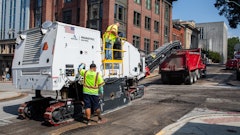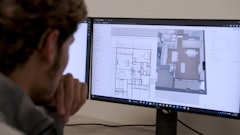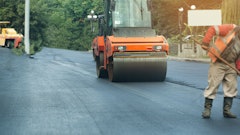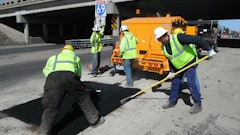
In the weeks since the collapse of the Francis Scott Key Bridge, there has been plenty of analysis conducted by supply chain experts, reporters, and government officials. The ramifications of the disaster have a far greater reach beyond that of local traffic disruptions, even while that is a major concern for residents. Due to the fact that this bridge contained a portion of Interstate 695, and connected to the ninth largest US port, it means the arterial roadway's value extends to the entire region.
“The tragic collapse of the Key Bridge in Baltimore has had a significant impact on businesses across Maryland, disrupting the movement of goods and people throughout the region,” said Mary D. Kane, president & CEO of the Maryland Chamber of Commerce. “This event has underscored the crucial role that our nation’s infrastructure plays in supporting the daily lives of our citizens and the smooth functioning of our economy. As the unified voice of the Maryland business community, we are committed to continuing to work with our Building Bridges to Recovery Coalition, state and federal partners, as well as businesses across the state to advocate for the resources and policies needed to address these infrastructure challenges and preserve the resilience of our supply chains.”
TRIP, a national transportation research nonprofit, released a new report that underscores the enormous economic value that travels via the interstate highway system, as well as the need to preserve and improve that system with greater and new investments. The "supply chain" is a term frequently tossed around whenever one of these unfortunate incidents occur, like the Philadelphia fire and bridge collapse in 2023, and it can be difficult for many people to put it into concrete terms. However, the flip-side of these accidents is that it can make that nebulous concept more tangible.
Whether goods arrive by train, ship, or plane, one thing that remains constant is that at least the last leg of that journey is going to be on the bed of a truck, traveling the interstate highway system. Here are some figures from the TRIP report that demonstrate the significant usage large combination trucks put on our roadways.
In 2022 the U.S. freight system moved 19.7 billion tons of freight, valued at $18.8 trillion, with trucks carrying 72% of freight by value and 64% by weight. From 2000 to 2022, vehicle miles of travel by large commercial trucks in the U.S. increased by 44%. From 2022 to 2050, freight moved annually in the U.S. by trucks is expected to increase 93% in value (inflation-adjusted dollars) and 47% by weight. U.S. business logistics costs reached $2.3 trillion in 2022, representing 9.1% of U.S. GDP – the highest share ever.
The big funding figures published in this current report actually comes from a 2019 Transportation Research Board (TRB) study, Renewing the National Commitment to the Interstate Highway System: A Foundation for the Future, which characterizes the current infrastructure shortcomings in the US as due to age, heavy use, and repeated deferments from investment. The report calls for an increase in highway spending from the 2018 $23 billion level, to $57 billion annually for the next twenty years. That sounds like a huge leap, except that the Infrastructure and Jobs Act (IIJA) signed into law on November 15, 2021, committed $350 billion in highway and bridge funds over a five year span, ending in 2026.
Here's a graphical breakdown.
 https://www.statista.com/statistics/1362134/highway-funding-on-the-iija-in-the-us-by-program/
https://www.statista.com/statistics/1362134/highway-funding-on-the-iija-in-the-us-by-program/
Also, the 2024 fiscal year budget request for the FHWA totaled $60.8 billion, which when added to the $9.5 billion in advances appropriations contained in the IIJA, resulted in a grand total of $70.3 billion. In addition, the Budget proposes to repurpose $60 million to make impactful change, particularly in underserved communities, through the Active Transportation Infrastructure Investment Program (ATIIP). Clearly, there is a lot of funding going into our national infrastructure, even up to and exceeding what experts have called for. The question might be then, is the money going to the best solutions?
According to TRIP, "In 2022, thirteen percent of travel on Interstate highways and twenty-two percent of travel on rural Interstate highways was by combination trucks and fifty-seven percent of large commercial truck vehicle miles of travel in 2022 was on Interstate highways." These types of vehicles are the most taxing on road pavements, in some cases, capable of stressing structural integrity as much as 2,500 times that of an average sedan.
Concerning the latest report Carolyn Kelly, Director of Communication & Research for TRIP, told Forconstructionpros, "While this report doesn't necessarily break any new ground, it does highlight our dependence on these vital pieces of infrastructure, whether they be bridges or otherwise, and it reinforces the need to properly maintain and invest in them to reduce disruptions of this kind."
While the most recent crisis wasn't necessarily a direct result of infrastructure neglect and decline, there are still an estimated three percent of bridges in poor condition on the national highway system, and nearly sixty percent are considered fair condition. Funding for those upgrades and repairs are absolutely essential, that is unquestionable.
Here is a chart, provided by TRIP that shows, "state-by-state data for freight movement by value and weight, the projected increase in freight movement by value and weight from 2022-2050, the share of vehicle miles of travel (VMT) by combination trucks on the Interstate and on Rural Interstates, and the share of Interstate bridges in poor and fair condition."
 State-by-state data for freight movement by value and weight, the projected increase in freight movement by value and weight from 2022-2050, the share of vehicle miles of travel (VMT) by combination trucks on the Interstate and on Rural Interstates, and the share of Interstate bridges in poor and fair condition.TRIP
State-by-state data for freight movement by value and weight, the projected increase in freight movement by value and weight from 2022-2050, the share of vehicle miles of travel (VMT) by combination trucks on the Interstate and on Rural Interstates, and the share of Interstate bridges in poor and fair condition.TRIP



























